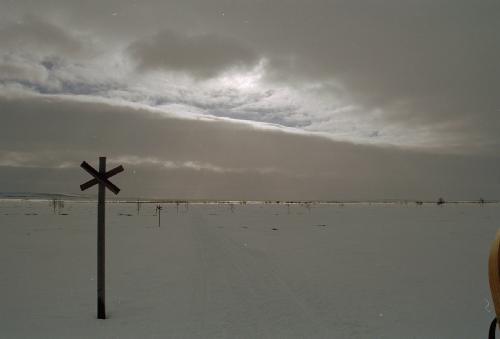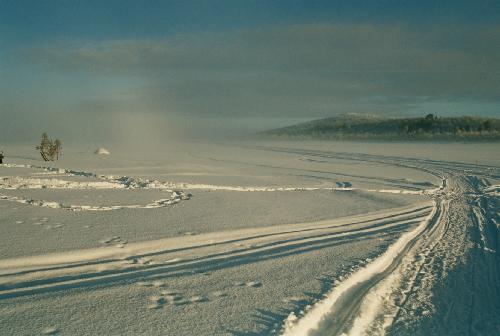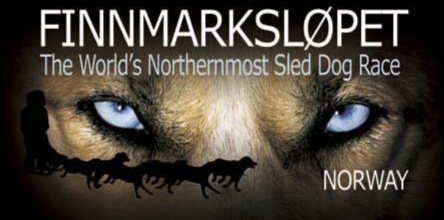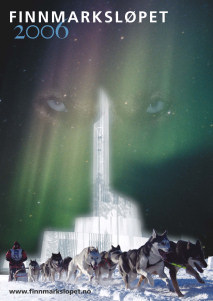 FINNARKSLOPET ( www.finnmarkslopet.no
)
FINNARKSLOPET ( www.finnmarkslopet.no
)
The North of Europe is the symbol of vast
free space rimmed by the frozen rivers, large spacious and icy
lakes with the snow blown away, vast plains where there is nothing
to bound you and your pack of sled dogs. When you want to weather
the storm and stand up to obstacles, it is very necessary to learn
to live and travel with dogs with the feeling of resignation to
space, uncertainty where exactly you are and with the question
if someone helps you. Is is also very important to have the ability
to fight the unpleasant quirk of the arctic “Mrs. Winter” that
has been ruling here strictly but fairly. She plays for those
who are prepared. To have or not to have these abilities and skills
makes a big difference between the mushers living in the North
and those from the down south of Europe so called the Southrons.

 Most
of the competitions down in Europe, even the longest ones, are
the stage races. The only reason for that is basically that you
will never find there 500km trail in one piece that would be suitable
for such a long race. Not only you won’t find the 500km trail
but you will definitely not find even the 350km, 200km nor 100km
unless you would have to make varieties, twists, turns and crossings
in one place. The most usual solution is that you pass the stage
and at the finish is waiting a car with the boxes for dogs, all
necessary material and comfort for the musher who can enjoy a
hot shower, cosy accommodation and evening entertainment in a
restaurant. The next day you finish another stage on a well-prepared
and well-marked trail checked by the organizators and the helpers
and if you are discontent you can give a protest.
Most
of the competitions down in Europe, even the longest ones, are
the stage races. The only reason for that is basically that you
will never find there 500km trail in one piece that would be suitable
for such a long race. Not only you won’t find the 500km trail
but you will definitely not find even the 350km, 200km nor 100km
unless you would have to make varieties, twists, turns and crossings
in one place. The most usual solution is that you pass the stage
and at the finish is waiting a car with the boxes for dogs, all
necessary material and comfort for the musher who can enjoy a
hot shower, cosy accommodation and evening entertainment in a
restaurant. The next day you finish another stage on a well-prepared
and well-marked trail checked by the organizators and the helpers
and if you are discontent you can give a protest.

 You
will find the real long-distance races only in the Northern Europe
or in Alaska. There is the start and then you will meet the others
either at the finish or at the checkpoint but only after you have
passed a couple of woeful days. According to the rules it is forbidden
to accept any help from the helpers. The organizators deliver
and store the spare material in signed bags at the certain checkpoints
along the trail. You have nothing more than what you pack beforehand.
It is only your personal matter how you organize your things,
everything depends on your experience, foresight and your strategy.
Another speciality of these long races is that you have to travel
about the same time day and night too. No one waits here for the
dawn or better weather. You have to move forward no matter if
is daytime, night time, bright sky or gale. Most of the mushers
stop only for serious reasons and also at the compulsory breaks
that are there to provide enough rest for the dogs. It is undisputable
that one cannot win such a long distance competition for the first
time when he or she does not know the terrain and the specification
of each of the trails.
You
will find the real long-distance races only in the Northern Europe
or in Alaska. There is the start and then you will meet the others
either at the finish or at the checkpoint but only after you have
passed a couple of woeful days. According to the rules it is forbidden
to accept any help from the helpers. The organizators deliver
and store the spare material in signed bags at the certain checkpoints
along the trail. You have nothing more than what you pack beforehand.
It is only your personal matter how you organize your things,
everything depends on your experience, foresight and your strategy.
Another speciality of these long races is that you have to travel
about the same time day and night too. No one waits here for the
dawn or better weather. You have to move forward no matter if
is daytime, night time, bright sky or gale. Most of the mushers
stop only for serious reasons and also at the compulsory breaks
that are there to provide enough rest for the dogs. It is undisputable
that one cannot win such a long distance competition for the first
time when he or she does not know the terrain and the specification
of each of the trails.

 Some
of the most famous races of this type are IDITAROD (www.iditarod.com
, www.cabelasiditarod.com)
and YUKON QUEST ( www.yukonquest.com)
in Alaska for 1000 miles, which is for 1800km. Northern Europe
is smaller compared to Alaska and so the longest European race
FINNMARKSLOPET ( www.finnmarkslopet.no
) is “only” for 1000km. For your imagination that is the distance
from Prague to Venetia. You can easily drive this distance by
a car in 10-15 hours depending on the traffic and your car speed.
Your dogs though can get over such distance after a couple of
days of strenuous run and it can easily happen that you just do
not get over this distance just because you or your dogs cannot
do it. For such distance it does not divide to “you” and “your
dogs”. You are there together and it depends on each of you if
you come to the finish. Here comes the truth about the quality
and painstaking preparation, the physical condition, equipment
and mostly the psychical resistance.
Some
of the most famous races of this type are IDITAROD (www.iditarod.com
, www.cabelasiditarod.com)
and YUKON QUEST ( www.yukonquest.com)
in Alaska for 1000 miles, which is for 1800km. Northern Europe
is smaller compared to Alaska and so the longest European race
FINNMARKSLOPET ( www.finnmarkslopet.no
) is “only” for 1000km. For your imagination that is the distance
from Prague to Venetia. You can easily drive this distance by
a car in 10-15 hours depending on the traffic and your car speed.
Your dogs though can get over such distance after a couple of
days of strenuous run and it can easily happen that you just do
not get over this distance just because you or your dogs cannot
do it. For such distance it does not divide to “you” and “your
dogs”. You are there together and it depends on each of you if
you come to the finish. Here comes the truth about the quality
and painstaking preparation, the physical condition, equipment
and mostly the psychical resistance.

 The
dog-sledding competition FINNMARKSLOPET
has been organized since 1981. In those years there have been
a lot of changes in distance and categories. The race has been
divided into the open and limited category in 1998 and has been
valid to recent days. In the open category you make teams of 14
dogs for 1000km long trail and one of the conditions of applying
is to finish such a race (400km and longer) in the past. In the
limited category there start teams of 8 dogs for 500km long trail.
Every “rookie” who believes his strength can apply for this race
that starts and finishes in a Norwegian town Alta.
The
dog-sledding competition FINNMARKSLOPET
has been organized since 1981. In those years there have been
a lot of changes in distance and categories. The race has been
divided into the open and limited category in 1998 and has been
valid to recent days. In the open category you make teams of 14
dogs for 1000km long trail and one of the conditions of applying
is to finish such a race (400km and longer) in the past. In the
limited category there start teams of 8 dogs for 500km long trail.
Every “rookie” who believes his strength can apply for this race
that starts and finishes in a Norwegian town Alta.

 The
North of Norway and Norway itself is quite inaccessible to the
rest of the dogs´ world for its distance and difficult Norwegian
legislature – necessary entering animal blood tests in the authorized
veterinary laboratories. For this reason it becomes easier to
get to the neighbouring Finland where there apply no such conditions.
The
North of Norway and Norway itself is quite inaccessible to the
rest of the dogs´ world for its distance and difficult Norwegian
legislature – necessary entering animal blood tests in the authorized
veterinary laboratories. For this reason it becomes easier to
get to the neighbouring Finland where there apply no such conditions.
 The
difficulty of the competition and its isolation are the two main
reasons why mainly the local champions take part but in the last
years we can start finding some competitors of the South on the
final result lists too. If you read the profiles of the competitors
on the websites of the race you will learn that most of them goes
in this race just because it is tradition or because it is organized
in their home place (noticeable advantage). Some of them even
moved there (to get this advantage). The last reason is that it
is something like the last test if the team is able to pass such
a strenuous race, which is also the starting point leading to
the dream race of all the mushers – the IDITAROD. FINNMARKSLOPET
is the only European test and the only recommendation for mushers
heading over the ocean with their teams.
The
difficulty of the competition and its isolation are the two main
reasons why mainly the local champions take part but in the last
years we can start finding some competitors of the South on the
final result lists too. If you read the profiles of the competitors
on the websites of the race you will learn that most of them goes
in this race just because it is tradition or because it is organized
in their home place (noticeable advantage). Some of them even
moved there (to get this advantage). The last reason is that it
is something like the last test if the team is able to pass such
a strenuous race, which is also the starting point leading to
the dream race of all the mushers – the IDITAROD. FINNMARKSLOPET
is the only European test and the only recommendation for mushers
heading over the ocean with their teams.
 The
race itself in Norwegian Alta enjoys the great attention of the
locals. The opening is followed by the impressive celebration
in which are the competitors introduced. In the slowly prolongating
frosty days this race means for most of the local inhabitants
that the spring is coming. If we take in account that there aren’t
many culture possibilities throughout the year then it is clear
that after such a long and dark winter people need the reason
to celebrate. There come myriad of spectators. It is nothing unusual
that for the start of the race arrive even the members of the
Norwegian royal family. This race became a remarkable Norwegian
sports festival. The race has been started by the Her Majesty
Norwegian princess in the last couple of years.
The
race itself in Norwegian Alta enjoys the great attention of the
locals. The opening is followed by the impressive celebration
in which are the competitors introduced. In the slowly prolongating
frosty days this race means for most of the local inhabitants
that the spring is coming. If we take in account that there aren’t
many culture possibilities throughout the year then it is clear
that after such a long and dark winter people need the reason
to celebrate. There come myriad of spectators. It is nothing unusual
that for the start of the race arrive even the members of the
Norwegian royal family. This race became a remarkable Norwegian
sports festival. The race has been started by the Her Majesty
Norwegian princess in the last couple of years.
 There
are crowds of the visitors and spectators along the trail at its
start but as the little town fades away in the distance the crowds
become smaller and people slowly disappear. In the end the musher
rides completely alone just with his/her dogs surrounded only
by the icy and snowy countryside where the temperatures can reach
the extremes.
There
are crowds of the visitors and spectators along the trail at its
start but as the little town fades away in the distance the crowds
become smaller and people slowly disappear. In the end the musher
rides completely alone just with his/her dogs surrounded only
by the icy and snowy countryside where the temperatures can reach
the extremes.


 The
results of this year race (2007) suggest that the race for 500km
seems to be a ladies matter.At the first three medal places were
women. The first came a Norwegian Elisabeth Edland in the time
of 2 days 7 hours and 47 minutes, followed by a Swede Katy Maier
1 hour 48 minutes slowlier time and then the third Norwegian Mona
Kolstad with the lost of 2 hours 38 minutes. Isabelle Travadon,
the famous French competitor came the 29th and got 18 hours and
11minutes. The interesting fact about her is that she rides with
Siberian Husky and that at the first checkpoint she arrived as
the 64th. At the 500km race this year started 69 mushers and 42
of them finished it.
The
results of this year race (2007) suggest that the race for 500km
seems to be a ladies matter.At the first three medal places were
women. The first came a Norwegian Elisabeth Edland in the time
of 2 days 7 hours and 47 minutes, followed by a Swede Katy Maier
1 hour 48 minutes slowlier time and then the third Norwegian Mona
Kolstad with the lost of 2 hours 38 minutes. Isabelle Travadon,
the famous French competitor came the 29th and got 18 hours and
11minutes. The interesting fact about her is that she rides with
Siberian Husky and that at the first checkpoint she arrived as
the 64th. At the 500km race this year started 69 mushers and 42
of them finished it.
 At
the 1000km race started 38 mushers and 29 of them finishedit.
The winner was a Norwegian Tore Bergby with the time 5 days, 20
hours and 49 minutes. The last successful competitor who finish
race for 1000 km was a Brittish Ben Livesey. He came to the finish
2 days, 2 hours and 35 minutes after the first one.
At
the 1000km race started 38 mushers and 29 of them finishedit.
The winner was a Norwegian Tore Bergby with the time 5 days, 20
hours and 49 minutes. The last successful competitor who finish
race for 1000 km was a Brittish Ben Livesey. He came to the finish
2 days, 2 hours and 35 minutes after the first one.
The everage age of competitors in this race is 40 years and the
oldest participant was 65. Well, it is looks as enough time to
do something in next years...
 There
came an idea. It´s time for challenge and big deeds...
There
came an idea. It´s time for challenge and big deeds...

The preparation for the
race


